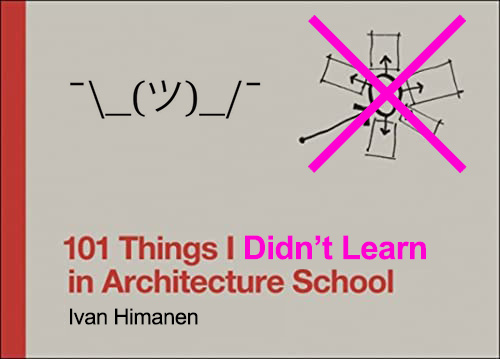The longer I practice architecture, the more I learn about what I do not know. Particularly stinging are the “unknown unknowns” as a U.S. Secretary of Defense might call them. For architects, “known unknowns” might include specialized knowledge within categories that we were introduced to in school but never had time to dig into. For example, we took a Building Systems class to study mechanical, electrical, and plumbing (MEP) basics but never learned exactly how to calculate airflow or how many transformers a building will need. We studied city planning and the evolution of building form but never took the time to open the Zoning Resolution and cite the chapter and verse that regulates setbacks. But those, we understood, we would do given some time. In the true spirit of architects being jacks of all trades but masters of none, the idea is that we enter the workforce having a mental map of all the professions, trades, and areas of expertise we’ll need to collaborate with in order to get buildings built. However, 10 years into the game, I’ve found the map drawn up in academia to be lacking. Not to disparage the quality of the training I went through at The Cooper Union, but there are some aspects of getting buildings built that were simply not on the map. I had to discover them in the working world. Crucially, and to give credit where it’s due, Cooper’s B.Arch program taught me the importance of seeking new knowledge. Thus, any new continents of expertise I run aground fill me with a blend of humility and nerdy excitement– humility to acknowledge that I am just a visitor there, that it’s incumbent upon me to learn the language and customs of the people and not even think about conquering– nerdy excitement to avoid dabbling, trying honestly to immerse myself in the ways of the place. This attitude often signals to the continent’s inhabitants that I come in peace, and they are more than willing to share their riches.
Over the years, if it happens that I fall out of touch with a peer and then reconnect years later, I’m eager to discreetly observe the different ways we developed professionally while we were apart. Sometimes I’ll notice this person has gotten stuck in a certain way of thinking, describing their work experiences in terms that are only relevant to architects with blinders on– egress plans, stair details, problems with Revit crashing, or the next design deadline. They do not mention anything about the client’s business model, project financing, local politics, schedule, design fee, procurement, market trends, names of the authorities having jurisdiction or the fire marshal, logistics, specs for mechanical or electrical equipment, and a dozen other dimensions of the project that dwarf the architecture in comparison. Mind you these friends are all intelligent, but they aren’t curious, and since leaving school they have turned into a kind of specialist staying only in their architectural lane while still believing they are the generalist they were educated to become.
If you can’t elaborate on any items in the above list, I would like to write a book for you. Inspired by Matthew Frederick’s 101 Things I Learned In Architecture School, I propose a book called 101 Things I Didn’t Learn In Architecture School. Its purpose is to illuminate the many fields of knowledge in an accessible way for architects, teach them that there are things beyond their design, and show them that the more interested they are in those things the better a time they’ll have in their careers.
The book shall start with a generic curriculum of a Bachelor of Architecture program in America. I’ll build it by “averaging” all the NAAB-accredited B.Arch programs in the country (about 150). Then I’ll identify which dimensions of the real world it leaves unaddressed. Each subsequent chapter will be dedicated to one of those. Ideally the chapters will be stories about how that particular story made or broke a project, but peppered throughout with vignettes explaining in simple terms how that thing works. A city council ruling puts the kibosh on a mixed-use development– I will tell that story as if I were a journalist, but pause in the middle to explain how the city council works, who they are, and what architects or engineers can do to avoid political rejection. A big transportation project runs billions of dollars over budget and years past schedule– I will trace back the nuances of the contract, explain what goes down in the meeting where the City decides to delay the project and why they made that decision, what the lawyers are scrambling to write behind the scenes, and where exactly those billions of dollars are coming from. A new building is built to massive success, but only thanks to a new material that allows spans between columns to be greater– I will backtrack the supply chain, recounting the research, testing, international trade agreements, and regulatory approvals that it took to get that new material into the market so that the architect could specify it. Some chapters may resemble reports regularly released by city agencies in which they outline administrative goals, major legislation, or in-depth studies they have conducted– much shorter, of course.
My whole career I’ve tried to conduct myself as if I were still in school– never casing to learn. It does have its downsides, like I may never be invited to write an article or give a lecture because I will never become the go-to guy for any particular topic, but the advantage is that I can attend each and every one of those lectures and not fall asleep. Here’s to keeping the rest of the profession awake, taking our blinders off, and drifting gleefully into other lanes.
